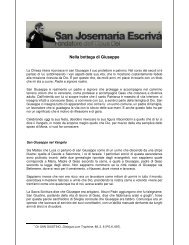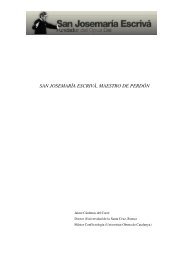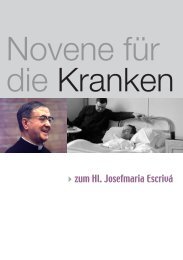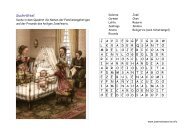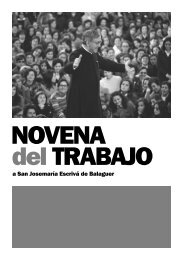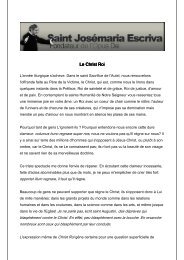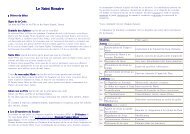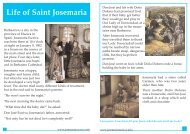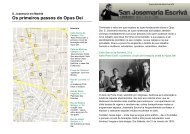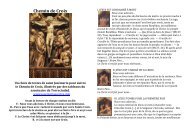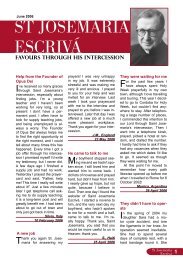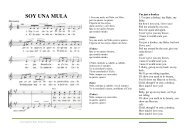Download the tour with map (pdf format) - Saint Josemaria Escriva
Download the tour with map (pdf format) - Saint Josemaria Escriva
Download the tour with map (pdf format) - Saint Josemaria Escriva
You also want an ePaper? Increase the reach of your titles
YUMPU automatically turns print PDFs into web optimized ePapers that Google loves.
St <strong>Josemaria</strong> <strong>Escriva</strong> in Madrid<br />
The founding of Opus Dei<br />
www.josemariaescriva.info<br />
Fr <strong>Josemaria</strong> <strong>Escriva</strong> moved to Madrid in April 1927. He once said, “It<br />
was in Madrid that I received my mission, and for that and o<strong>the</strong>r<br />
reasons I feel that I have full right to call myself ‘a person of Madrid’.”<br />
1. Garcia de Paredes Street:The founding of Opus Dei<br />
At 45, Garcia de Paredes Street, Madrid, stands <strong>the</strong> Basilica of La<br />
Milagrosa, belonging to <strong>the</strong> Vincentian Fa<strong>the</strong>rs.<br />
The first stone of <strong>the</strong> Central House of <strong>the</strong> Vincentians was laid on <strong>the</strong><br />
feast of St Joseph, 1883, and <strong>the</strong> building is now occupied by La<br />
Milagrosa Hospital. It was here that Fr <strong>Josemaria</strong> <strong>Escriva</strong> founded<br />
Opus Dei on October 2, 1928.<br />
The Central House of <strong>the</strong> Vincentian Fa<strong>the</strong>rs was a large, four-story brick<br />
building <strong>with</strong> simple and austere rooms opening into corridors, and <strong>with</strong> a<br />
large interior patio garden. Next to that building, at <strong>the</strong> corner where<br />
Garcia de Paredes Street begins, was <strong>Saint</strong> Vincent de Paul Church, now<br />
<strong>the</strong> Basilica of La Milagrosa (Our Lady of <strong>the</strong> Miraculous Medal), built in<br />
1904. Behind it was “a large kitchen garden – fertile, verdant, colorful,<br />
and luxuriant – <strong>with</strong> various flower beds separated by walkways covered<br />
by leafy fruit and shade trees” (cf. Guia de Arquitectura y Urbanismo de<br />
Madrid; in <strong>the</strong> 1940s this building underwent a substantial trans<strong>format</strong>ion,<br />
and a good part of <strong>the</strong> old construction is now a hospital. The rest, rebuilt<br />
and enlarged, is now <strong>the</strong> residence of <strong>the</strong> Vincentian community that staffs<br />
<strong>the</strong> Basilica of La Milagrosa). As <strong>the</strong> years went by, <strong>the</strong>se enormous open<br />
spaces of vegetable and flower gardens – which extended to Cuatro<br />
Caminos, alternating <strong>with</strong> ancestral homes and built-up areas – were eaten<br />
up by <strong>the</strong> city’s expansion.<br />
From Sunday, September 30, through October 6, St Josemaría did a<br />
spiritual retreat at <strong>the</strong> Central House of <strong>the</strong> Vincentians <strong>with</strong> five o<strong>the</strong>r<br />
priests. Wake-up time was 5 a.m., and bedtime was 9 p.m. In between<br />
<strong>the</strong>re were examinations of conscience, Mass, talks, <strong>the</strong> Divine Office...<br />
On <strong>the</strong> morning of Tuesday, October 2, feast of <strong>the</strong> guardian Angels, after<br />
celebrating Mass, Fa<strong>the</strong>r Josemaría was in his room, reading <strong>the</strong> notes he<br />
had brought <strong>with</strong> him. Suddenly an extraordinary grace came over him,<br />
and he understood that our Lord was responding to those insistent<br />
petitions, Domine, ut videam! and Domine, ut sit! – Lord, that I may see!<br />
Lord, that it may be!<br />
The Church of La Milagrosa today
earthly tasks, are called to sanctify <strong>the</strong>mselves and <strong>the</strong>ir work. In this light<br />
he saw that <strong>the</strong> Work (as yet unnamed) was destined to promote <strong>the</strong> divine<br />
plan of <strong>the</strong> universal call to holiness; that from <strong>with</strong>in its heart, as an<br />
instrument of God’s Church, would radiate <strong>the</strong> <strong>the</strong>ological principles and<br />
supernatural spirit needed for <strong>the</strong> renewal of peoples. With immense<br />
astonishment he understood, deep in his soul, that that illumination was<br />
not only <strong>the</strong> answer to his petitions, but also an invitation to accept a<br />
divine commission.<br />
The decoration of a chapel in <strong>the</strong> church of Our Lady of <strong>the</strong> Angels<br />
recalls <strong>the</strong> founding of Opus Dei<br />
Three years later, he described <strong>the</strong> gist of it like this: “I received an<br />
illumination about <strong>the</strong> entire Work, while I was reading those papers.<br />
Deeply moved, I knelt down – I was alone in my room, at a time<br />
between one talk and <strong>the</strong> next – and gave thanks to our Lord, and I<br />
remember <strong>with</strong> a heart full of emotion <strong>the</strong> ringing of <strong>the</strong> bells of <strong>the</strong><br />
Church of Our Lady of <strong>the</strong> Angels.”<br />
Under <strong>the</strong> powerful and ineffable light of grace he was shown <strong>the</strong><br />
Work as a whole; “saw” is <strong>the</strong> word he always used when relating this<br />
event. These were moments of indescribable grandeur. As he prayed he<br />
saw displayed <strong>with</strong>in his soul <strong>the</strong> historical panorama of <strong>the</strong><br />
redemption of mankind, illuminated by God’s love. At that moment, he<br />
comprehended in a way that could not be expressed in words <strong>the</strong> divine<br />
core of <strong>the</strong> exalted vocation of Christians who, in <strong>the</strong> midst of <strong>the</strong>ir<br />
Into <strong>the</strong> room, at this<br />
moment of prayer, flooded <strong>the</strong><br />
jubilant sound of <strong>the</strong> pealing of<br />
<strong>the</strong> bells of Our Lady of <strong>the</strong><br />
Angels, a church in <strong>the</strong> nearby<br />
neighborhood of Cuatro<br />
Caminos. That sound would stay<br />
<strong>with</strong> him forever. “Still<br />
resounding in my ears,” he said<br />
in 1964, “are <strong>the</strong> bells of <strong>the</strong><br />
Church of Our Lady of <strong>the</strong><br />
Angels, announcing <strong>the</strong> feast of<br />
its patroness.”<br />
There is always a hidden treasure<br />
in small things done <strong>with</strong> love<br />
and perfection – in difficulties<br />
and joys, in a job well done, in<br />
service to society or one’s<br />
neighbor. Professional work and<br />
social relations are <strong>the</strong> milieu and<br />
“I remember <strong>with</strong> a heart full of<br />
emotion <strong>the</strong> ringing of <strong>the</strong> bells of<br />
<strong>the</strong> Church of Our Lady of <strong>the</strong><br />
Angels,” said St <strong>Josemaria</strong>. One of<br />
<strong>the</strong>se bells is now in <strong>the</strong> shrine of<br />
Torreciudad.<br />
<strong>the</strong> matter that Christians must sanctify; <strong>the</strong>y must become saints in and<br />
through <strong>the</strong> fulfilling of <strong>the</strong>ir family and civic obligations. The universal<br />
call to sanctity implies, in o<strong>the</strong>r words, <strong>the</strong> sanctifying value of work<br />
offered to God and <strong>the</strong> Christian value of secular activities – <strong>the</strong> reality
that one can be detached from this world<br />
<strong>with</strong>out being absent from it, that mundane<br />
things can be used as a means for becoming<br />
sanctified, for becoming divinized.<br />
“In that ordinary life, as we go along through<br />
<strong>the</strong> world <strong>with</strong> our professional colleagues or<br />
coworkers, God our Fa<strong>the</strong>r gives us <strong>the</strong><br />
opportunity to exercise ourselves in all <strong>the</strong><br />
virtues: charity, fortitude, justice, sincerity,<br />
temperance, poverty, humility, obedience….”<br />
Thus <strong>the</strong> sciences and <strong>the</strong> arts, finance and<br />
politics, crafts and industry, housework, and<br />
all o<strong>the</strong>r honorable fields of endeavor no<br />
longer are indifferent or “profane.” Any activity carried out in union<br />
<strong>with</strong> Christ – <strong>with</strong> an upright spirit of sacrifice, love of neighbor, and<br />
perseverance, and <strong>with</strong> <strong>the</strong> intention of giving glory to God – is <strong>the</strong>reby<br />
ennobled and endowed <strong>with</strong> spiritual value.<br />
The young priest was to be <strong>the</strong> herald of a message for humanity “as<br />
old and as new as <strong>the</strong> Gospel itself”. But he saw himself as, at best, a<br />
humble, worthless donkey upon whom a precious and very heavy load<br />
had suddenly been placed. A beautiful burden, which he shared <strong>with</strong><br />
Our Lord, who was <strong>the</strong>re in <strong>the</strong> very depths of his soul. Fr <strong>Josemaria</strong><br />
described his calling in <strong>the</strong>se terms:<br />
“If you ask me how one recognizes a divine calling, how one comes to<br />
a realization of it, I will tell you that it is a new view of life. It’s as if a<br />
light were lit <strong>with</strong>in us: it is a mysterious impulse which urges us to<br />
devote our noblest energies to an activity which, <strong>with</strong> practice,<br />
becomes second nature to us. That vital force, which is something like<br />
an avalanche sweeping everything before it, is what o<strong>the</strong>rs call a<br />
vocation.”<br />
During that retreat <strong>with</strong> <strong>the</strong> Vincentians, he came to see how <strong>the</strong> Lord’s<br />
providential hand had prepared <strong>the</strong> foundation’s cornerstone by means of<br />
<strong>the</strong> sad events that had forced his family to move from Barbastro to<br />
Logroño, from Logroño to Saragossa, and from Saragossa to Madrid. In<br />
that light his life took on a new and full coloring. God had brought him to<br />
<strong>the</strong> capital city to plunge him into <strong>the</strong> very depths of <strong>the</strong> problems of<br />
humanity.<br />
“Yesterday evening, while walking down <strong>the</strong> street,” he would later write<br />
in his personal notes, “it occurred to me that Madrid has been my<br />
Damascus, because it was here that <strong>the</strong> scales fell from <strong>the</strong> eyes of my<br />
soul... and it was here that I received my mission.”<br />
He took an inventory of <strong>the</strong> material means on which he could count for<br />
this mission, and found that he had none at all. As his life progressed, <strong>the</strong><br />
Lord had been divesting him of all impediments. “I found myself <strong>the</strong>n<br />
alone, equipped <strong>with</strong> nothing but my twenty-six years and my good<br />
humor,” he said. On ano<strong>the</strong>r occasion he expressed it this way: “We<br />
started <strong>the</strong> Work, when our Lord wanted, <strong>with</strong> a complete lack of material<br />
means. I had only twenty-six years of age, <strong>the</strong> grace of God, and good<br />
humor. But that was enough.”<br />
A plaque records <strong>the</strong> place<br />
where Opus Dei was founded<br />
In 2000 <strong>the</strong> Vincentian Fa<strong>the</strong>rs of<br />
<strong>the</strong> Basilica of La Milagrosa put<br />
up a plaque inside <strong>the</strong> church<br />
recording <strong>the</strong> fact that it was<br />
<strong>the</strong>re that, in 1928, St <strong>Josemaria</strong><br />
<strong>Escriva</strong> received <strong>the</strong> divine<br />
inspiration to found Opus Dei.
The text of <strong>the</strong> plaque, preceded by <strong>the</strong> seal of Opus Dei, says: “On<br />
October 2, 1928, while he was doing a spiritual retreat in this house of<br />
<strong>the</strong> Vincentian Fa<strong>the</strong>rs, Blessed <strong>Josemaria</strong> <strong>Escriva</strong> de Balaguer<br />
received in his heart and mind <strong>the</strong> divine seed of Opus Dei: ‘I received<br />
<strong>the</strong> illumination about <strong>the</strong> entire Work: deeply moved, I knelt down – I<br />
was alone in my room – and gave thanks to our Lord, and I remember<br />
<strong>with</strong> a heart full of emotion <strong>the</strong> ringing of <strong>the</strong> bells of <strong>the</strong> Church of<br />
Our Lady of <strong>the</strong> Angels’.”<br />
PLACES NEARBY THAT ARE CONNECTED WITH THE<br />
HISTORY OF OPUS DEI<br />
2. Diego de Leon Street<br />
This building has a crypt which holds <strong>the</strong> mortal remains of <strong>the</strong> parents<br />
of <strong>the</strong> founder of Opus Dei.<br />
Fr <strong>Josemaria</strong> moved to this house on October 31, 1940. His mo<strong>the</strong>r,<br />
sister and bro<strong>the</strong>r moved <strong>the</strong>re shortly afterwards.<br />
In this house, Dolores, Fr <strong>Josemaria</strong>’s mo<strong>the</strong>r, died on April 22, 1941.<br />
Ano<strong>the</strong>r episode that took place in this center was one night when Fr<br />
<strong>Josemaria</strong> was too upset to sleep. His good name as a priest had been<br />
insulted and dishonoured. He got up from his bed. The oratory was<br />
close by. He went in and prostrated himself in front of <strong>the</strong> Tabernacle,<br />
and said to Our Lord, “Jesus, if you don’t need my good name, what do<br />
I want it for?” From that moment on, people could trample on his good<br />
name as much as <strong>the</strong>y liked; he was totally detached from his<br />
reputation.<br />
The building on Diego de Leon<br />
Street, Madrid, in 1940 and today<br />
3. Alcala Street: “The Sotanillo”<br />
In Opus Dei’s early days, when St <strong>Josemaria</strong> had no center to take <strong>the</strong>m<br />
to, he used to meet <strong>the</strong> young men he was doing apostolate <strong>with</strong> at “The<br />
Sotanillo” at 31 Alcala Street, Madrid.<br />
This establishment – a chocolate shop, bar, and cafeteria, all in one – was<br />
in a very central location: on Alcala, between Cibeles Square and<br />
Independencia Square. Its entrance was at street level, but from <strong>the</strong>re one<br />
had to go down a few steps, because it was in a semi-basement.<br />
He went back to bed in all tranquility, having abandoned into God’s<br />
hands whatever anyone might think about him.
Fa<strong>the</strong>r Josemaría greatly enjoyed <strong>the</strong> atmosphere of <strong>the</strong> Sotanillo and<br />
<strong>the</strong> company of his friends. The proprietor, Juan, and his son Angel got<br />
used to seeing <strong>the</strong> priest accompanied by students. Whichever of <strong>the</strong>m<br />
first saw him come in would call out, “Here he is, <strong>with</strong> his disciples.”<br />
4. Alcala Gate and Retiro Park<br />
In <strong>the</strong> Plaza de Independencia stands <strong>the</strong> Puerta de Alcala, or Alcala<br />
Gate. In this square, at 75 Alcala Street, Alvaro del Portillo was born<br />
on March 11, 1914.<br />
The Puerta de Alcala, toge<strong>the</strong>r <strong>with</strong> <strong>the</strong> Cibeles Fountain, is one of <strong>the</strong><br />
best-known sights in Madrid. It was built by Francisco Sabatini in<br />
1771. It is one of <strong>the</strong> great ornamental gates built during <strong>the</strong> reign of<br />
Carlos III, and commemorates his entry into <strong>the</strong> capital city.<br />
Retiro Park<br />
The name Retiro Park, or “Retreat<br />
Park”, originated <strong>with</strong> King Felipe II,<br />
who ordered it to be built as a place<br />
of spiritual retreat for <strong>the</strong> King<br />
during Lent, where he could pray and<br />
prepare for Holy Week. It was first<br />
called <strong>the</strong> Royal House of St Jerome.<br />
Later <strong>the</strong> Duke of Olivares named it<br />
<strong>the</strong> Royal House of <strong>the</strong> Good Retreat<br />
(Buen Retiro), from which comes its<br />
present name.<br />
St <strong>Josemaria</strong> often used to meet <strong>the</strong><br />
first people of Opus Dei and <strong>the</strong><br />
people he was doing apostolate <strong>with</strong>,<br />
here in this park, for a chat. Isidoro relates, “To begin <strong>with</strong> we didn’t have<br />
anywhere to go <strong>with</strong> <strong>the</strong> Fa<strong>the</strong>r. We would sit on a bench in <strong>the</strong> street.<br />
Then we started to go to Retiro Park, which was quieter, and would make<br />
plans for <strong>the</strong> future.”<br />
St <strong>Josemaria</strong> wrote in February 1932 that he would sometimes visit <strong>the</strong><br />
Park. “Last Saturday I was in Retiro Park from 12:30 to 1:30 (...) and I<br />
tried to read a newspaper. Prayer came upon me <strong>with</strong> such force that,<br />
against my will, I had to stop reading.”
Map <strong>with</strong> <strong>the</strong> places mentioned in this article<br />
1. Garcia de Paredes Street:The founding of Opus Dei<br />
2. Diego de León Street<br />
3. Alcala Street: “The Sotanillo”<br />
4. Alcala Gate and Retiro Park




